Change Page: 123 > | Showing page 1 of 3, messages 1 to 20 of 48 - powered by ASPPlayground.NET Forum Trial Version
Author
|
Message

|
 Breeding Journal, Species: Pseudochromis cyanotaenia
Friday, September 21, 2012 9:08 PM
Breeding Journal, Species: Pseudochromis cyanotaenia
Friday, September 21, 2012 9:08 PM
( permalink)
Breeding Journal DataSheet
This first post should be updated regularly to include new information as events take place or changes are made to your system General Species: Pseudochromis cyanotaenia Social Structure: Bonded pair Size of Individuals: 2 - 2 1/2" Age of Individuals: Unknown (wild caught) Date added to Tank: 9/21/2012 Broodstock Tank Details Size of Tank: 29 Gallons Substrate Details: Bare Bottom Filtration Details: HOB Filters (one for each side) Water Changes: As needed Water Temperature: 76 - 78 F Lighting: 24" T8 17W Lighting Cycle: Appx. 13H on / 11H off Other Tank Inhabitants: None Broodstock Feeding Details Food Types: Various frozen foods and pellets: Mysis, Spirulina Brine, Nutramar Ova, some Squid, Marine Cuisine, Rod's Food Regular, Rod's Food Fish Eggs, TDO C2, Oto EP-1, etc. Feeding Schedule: 2-4 times a day Spawning Details Date of First Spawn: 03/19/2013 Spawn Time of Day: Noon Dates of Consecutive Spawns: 04/01/2013, 04/08/2013, 04/20/2013 Courtship Details: Female is very gravid and swimming frantically at the divider. Male shows ABSOLUTELY INSANELY BRIGHT colors, and swims frantically at the divider. Egg Size: Small, < 1mm Egg Color: White Egg Count: Large egg mass -- over 1,000 Hatch Details Hatch Date: 3/23/2013 Hatch Time of Day: 10:00 PM # Days after Spawn: 4 Larvae Description: Tiny things with hardly any body, but large eyes. Consecutive Hatch Dates: 4/5/2013 Larval Tank Details Temperature: 78-80 F Size of Larval Tank: 15 Gallon BRT Substrate Details: None Other Tank Decor: None Filtration Details: Live phyto @ 200,000 cells / ml. Lighting: Compact fluorescent filtered with paper towels. Lighting Cycle: 24 hours on Water Changes: 15-50% every 1-2 days after the first week or so, decreased to more like 25-30% every 2-3 days after three weeks. Larval Feeding Details Food Types: Parvocalanus at first, then enriched rotifers. NHBBS started at Day 7. Enriched BBS started about Day 10. More Parvocalanus, Acartia, and Apocyclops fed at around two weeks. Tigriopus added at about three weeks. Feeding Schedule: Constant Metamorphosis/Settlement Date of Settlement Start: 5/6/2013 Days after Hatch: 31 Date of Settlement End: Description of Fry:
Grow-Out Tank Details Temperature: Size of Grow-Out Tank: Substrate Details: Other Tank Decor: Filtration Details: Lighting: Lighting Cycle: Water Changes: Size at Transfer: Age at Transfer: Grow-Out Feeding Details Food Types: Feeding Schedule: Additional Information (No Pictures or Videos in the Section Please) Miscellaneous Information: You will be required to provide photographic or video evidence in this thread of each event submitted for the MBI Program.
If your thread does not contain these photos the MBI Committee will not be able to approve your reports. PHOTOS AND VIDEO S MUST BE PLACED IN ADDITIONAL POSTS, NEVER IN THE FIRST POST IN A JOURNAL.
<message edited by JimWelsh on Tuesday, May 7, 2013 1:30 PM>
|
|
|
 Re:Breeding Journal, Species: Pseudochromis cyanotaenia
Friday, September 21, 2012 11:51 PM
Re:Breeding Journal, Species: Pseudochromis cyanotaenia
Friday, September 21, 2012 11:51 PM
( permalink)
I picked up this pair from Diver's Den the other day. They arrived just today, in excellent condition, as was expected. I have them in a tank that is set up almost exactly like the one I have my P. tapeinosoma in. 29 Gallons, with a divider, with a hole in the divider closed with a 3/4" PVC Plug + Cap combination. There are some PVC caves for them to hide in. They can see each other and interact, but cannot harm each other. The female of this pair is a little larger than the male is. Just like the first P. tapeinosoma pair I got, they both seem to want to get through the divider and kill each other. It will be interesting to see if there are any significant differences in the behavior of this pair relative to the behavior of the P. tapeinosoma pair, over time. Here are some lousy pictures I took today. Hopefully, I'll get some better pics soon. The male: 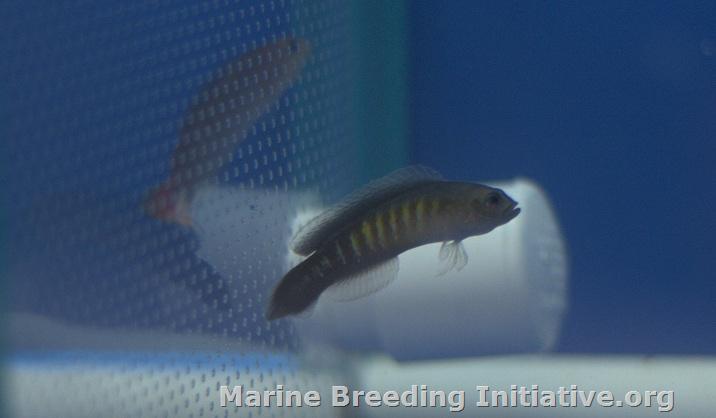 The female: 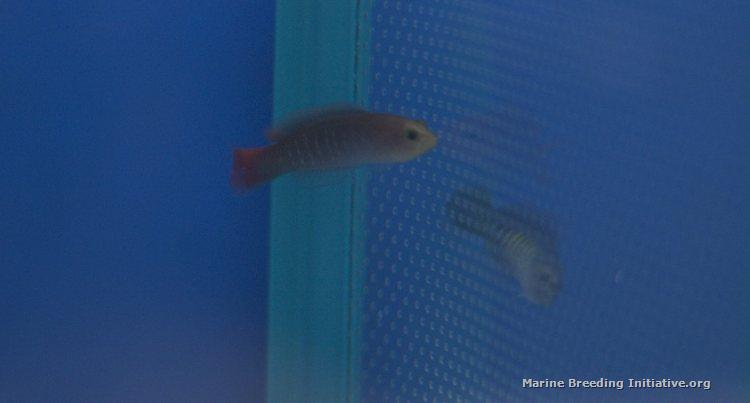
|
|
|
 Re:Breeding Journal, Species: Pseudochromis cyanotaenia
Sunday, September 23, 2012 9:21 PM
Re:Breeding Journal, Species: Pseudochromis cyanotaenia
Sunday, September 23, 2012 9:21 PM
( permalink)
Well, this male is one of the friendliest fishes I have ever met! He gladly eats pellets out of my hand just two days after arriving! He loves TDO C2 and OTO EP-1 right from my fingers at the water surface. The female is a bit more shy, but still does take the pellets enthusiastically. This pair still seems to spend most of their time trying to figure out how to breach the tank divider, and are threatening each other across the divider most of the day.
|
|
|
 Re:Breeding Journal, Species: Pseudochromis cyanotaenia
Sunday, September 23, 2012 11:01 PM
Re:Breeding Journal, Species: Pseudochromis cyanotaenia
Sunday, September 23, 2012 11:01 PM
( permalink)
very cool
|
|
|
 Re:Breeding Journal, Species: Pseudochromis cyanotaenia
Tuesday, March 19, 2013 4:44 PM
Re:Breeding Journal, Species: Pseudochromis cyanotaenia
Tuesday, March 19, 2013 4:44 PM
( permalink)
Well, after a long time I finally got a successful spawn today!
This pair has been a real problem. They are VERY aggressive towards each other. Even though my P. tapeinosoma pair are mean to each other when not spawning, the P. cyanotaenia make P. tapeinosoma look very tame in comparison.
Several times over the last several months, I'd see that the female was looking gravid, and the male was flashing colors, so I'd open the gate in the divider. Prior to today, each time, the timing just wasn't exactly right, though, and either the female would stay on her side, and the male would come chasing her over on her side, or else the female would come over to the male's side, but she wouldn't "obey" his leading her to his cave right away, and so he would start attacking her. One time, about a month ago, this latter behavior happened, so I closed the gate, but the male somehow managed to either squeeze past the edge of the divider or jumped onto the female's side, and the female beat the crap out of him. I found him a few hours later, cowering at the very top of the divider. He has since recovered, but she really tore him up that time.
For the last few days, I've been watching as the female has been looking plumper and plumper, and each day, the male is flashing his colors, and each day, I open the gate, and each time, the female would go to the male's side, and just get attacked when she wouldn't go into his cave when ordered to.
Today, the male had brighter colors than I've probably ever seen, and as soon as I opened the gate, within literally 2-3 seconds, the female went dashing into his cave, followed a split second later by the male, and they stayed in there for at least half an hour. When the female did finally leave, the egg mass was still attached to her by a thread, so it came out with her, and then detached. I gently turkey-basted it into the male's PVC cave, and an hour later, I checked, and he is tending the eggs.
My rotifer culture is not ready for this, so I immediately placed a Reed Mariculture order for some fresh rotifers, which should arrive the day after tomorrow. If the male brings the eggs to term, then I expect the hatch on Saturday night.
|
|
|
 Re:Breeding Journal, Species: Pseudochromis cyanotaenia
Friday, March 22, 2013 1:50 AM
Re:Breeding Journal, Species: Pseudochromis cyanotaenia
Friday, March 22, 2013 1:50 AM
( permalink)
As of tonight, the male is still tending the egg ball. It is in the very back of the PVC cave, and is very difficult to photograph, so I'm going to take a picture of the egg mass right before hatching, and I hope that will suffice for the spawn report. The Reed Mariculture rotifer order arrived a day earlier than expected (I called to ask when it would ship, and I was told that I missed the deadline, but then it shipped the same day anyway -- Reed Mariculture customer service ROCKS!). So, I am set with rotifers. I am ready to hatch BBS when necessary. I have RotiGreen Omega for greenwater and also have live Nannochloropsis for greenwater, too. ChlorAm-X is ready, too.
|
|
|
 Re:Breeding Journal, Species: Pseudochromis cyanotaenia
Sunday, March 24, 2013 2:59 AM
Re:Breeding Journal, Species: Pseudochromis cyanotaenia
Sunday, March 24, 2013 2:59 AM
( permalink)
|
|
|
 Re:Breeding Journal, Species: Pseudochromis cyanotaenia
Sunday, March 24, 2013 3:10 AM
Re:Breeding Journal, Species: Pseudochromis cyanotaenia
Sunday, March 24, 2013 3:10 AM
( permalink)
The hatch was done according to the protocol Tal has outlined for dottybacks. Basically, it is simply to tumble them in a cut-down brine shrimp hatcher with a strong light on them right after "lights out". I was getting worried after about 15 minutes, because none of them were hatching. At one point, the egg mass caught a big bubble of air, and was suspended at the top, but wasn't tumbling any more, so I poked at it with my finger to release the air bubble, and I immediately noticed a few larvae had hatched. Thinking that my touch might have induced the hatch, and recalling other written reports of male dottybacks biting and shaking the egg mass vigorously at hatch time, I started poking at it some more with my finger, and lo and behold, a bunch more larvae hatched! I continued to jiggle and swirl the egg mass with my finger, and the more I jostled it, the more and more the larvae hatched! This continued for probably about 1/2 hour, until all of the eggs had hatched. All the while, I was pouring the hatched larvae out of the tumbler, into the BRT, and replacing the tumbler water with water taken from the far, unlit edge of the BRT with a small beaker. I was suprised to see that this hatch was a HUGE number of larvae -- well over 1,000 in my estimation, and probably closer to 1,500! I had previously added a combination of live Isochrysis + Pavlova + Tetraselmis at a very light density of about 200,000 cells / ml to the 20 liters of broodstock tank water in the BRT. I added enough rotifers to get the density up to around 20 / ml or so, perhaps even a little more dense. I also dosed a moderate amount of RotiGreen Omega, and a commensurate amount of ChlorAm-X. Here are some pictures of the larvae: 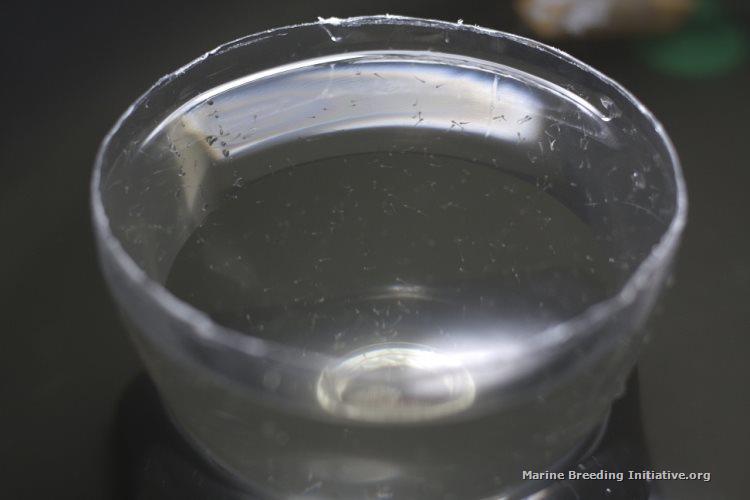 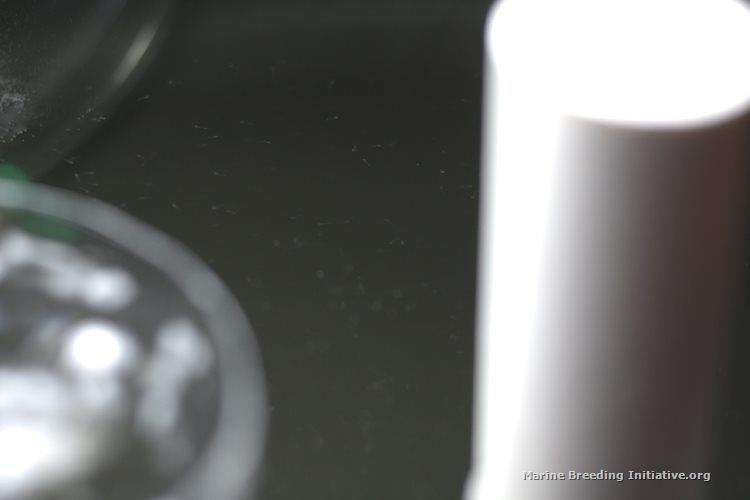 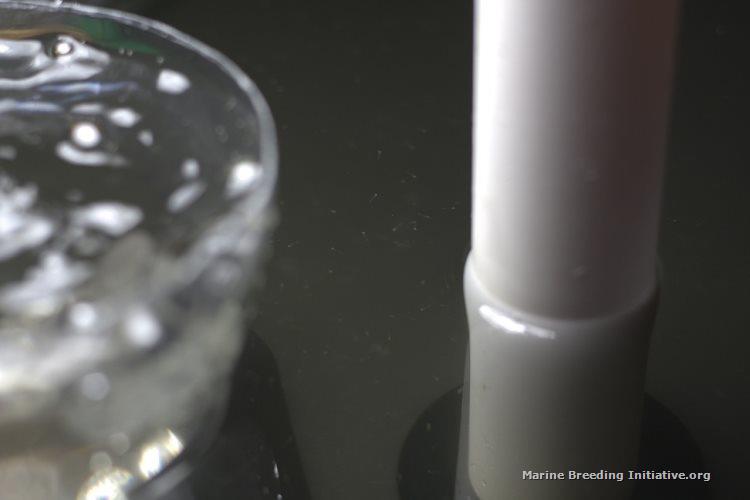
|
|
|
 Re:Breeding Journal, Species: Pseudochromis cyanotaenia
Sunday, March 24, 2013 12:48 PM
Re:Breeding Journal, Species: Pseudochromis cyanotaenia
Sunday, March 24, 2013 12:48 PM
( permalink)
I didnt know you still had this pair. Awesome! So do you think you'll get a good and comparable survival rate with rotifers over rotifers + copepods or just copepods?
|
|
|
 Re:Breeding Journal, Species: Pseudochromis cyanotaenia
Sunday, March 24, 2013 1:57 PM
Re:Breeding Journal, Species: Pseudochromis cyanotaenia
Sunday, March 24, 2013 1:57 PM
( permalink)
One thing is for sure: I'm not going to give them Apocyclops! With P. tapeinosoma, each time I gave them Apocyclops, I had massive dieoff within 48 hours. This time, I do have plenty of Parvocalanus and Acartia that I could give them, but I've been admonished by Matt Pedersen after the tapeinosoma debacle to just go with what has been proven to work: rotifers and BBS.
I have enough of these guys to separate some out in to a 2nd BRT and experiment, though, which is what I most likely will do.
|
|
|
 Re:Breeding Journal, Species: Pseudochromis cyanotaenia
Tuesday, April 2, 2013 12:24 AM
Re:Breeding Journal, Species: Pseudochromis cyanotaenia
Tuesday, April 2, 2013 12:24 AM
( permalink)
Well, I have made several mistakes with this first batch of larvae. First, with this very large number of larvae plus all the rotifers in such a relatively small volume of water, even with ChlorAm-X, I still had an ammonia spike after about 48 hours that killed off probably 75% of them. I siphoned out the dead larvae, and dosed more ChlorAm-X until the ammonia was under control. The next mistake was when I added the first NHBBS: I added too many, too soon. I added them on about day 5, which was almost certainly too soon. I have learned that I tend to significantly underestimate the number of BBS in a given volume -- I've done it in the past when working with various Hippocampus species, and I did it this time, too. It seems like I end up with somewhere between 10 - 100 times the amount I need! I have been adding Kanamycin together with the RotiGreen Omega and ChlorAm-X ever since I introduced the BBS. I do still have probably about 100 of the fry left at day 9, but between the excess rotifers and the excess (now several day old) BBS, I'm overwhelmed with too much food that clears the RotiGreen too quickly, and haven't yet gotten good enough at separating the larvae from the excess live food items. I'm basically chalking this batch up to a learning experience.
The good news is that the broodstock spawned again today, and I have another nice-looking egg mass that should hatch on Friday night, if all goes well. I plan to set up two BRTs for this next hatch, with a bit more than 5 gallons in each, and to split the hatch between the two BRTs. One BRT will get a plain vanilla rotifers + RotiGreen Omega + ChlorAm-X treatment, with a very few NHBBS on day 7 or 8, and Kanamycin once the BBS are added, and very few more BBS added as the first BBS are eaten. The second BRT will be treated with live copepods -- Parvocalanus at first, and Acartia added later on -- and a very light live phyto greenwater treatment. That's the plan at this point, at least.
|
|
|
 Re:Breeding Journal, Species: Pseudochromis cyanotaenia
Tuesday, April 2, 2013 10:08 AM
Re:Breeding Journal, Species: Pseudochromis cyanotaenia
Tuesday, April 2, 2013 10:08 AM
( permalink)
Great progress Jim!
Have you considered skipping the BBS and going straight to TDO or Oto A? What is the Kanamycin for? I've had troubles with hatching my Orchid Dottys, when you say a strong light just after "lights out" do you mean you let it be dark for awhile first or when lights out is supposed to happen you instead give them strong lighting?
Don't let fear and common sense stop you! =]
|
|
|
 Re:Breeding Journal, Species: Pseudochromis cyanotaenia
Tuesday, April 2, 2013 12:29 PM
Re:Breeding Journal, Species: Pseudochromis cyanotaenia
Tuesday, April 2, 2013 12:29 PM
( permalink)
Based on Matt Pedersen's Sunrise journal, I think it takes them a while to start taking OtoA. The Kananycin is because of the bacteria from the BBS. What I said about the "lights out" meant the latter.
|
|
|
 Re:Breeding Journal, Species: Pseudochromis cyanotaenia
Saturday, April 6, 2013 2:37 PM
Re:Breeding Journal, Species: Pseudochromis cyanotaenia
Saturday, April 6, 2013 2:37 PM
( permalink)
There was another spawn last Monday, and like clockwork, they hatched last night. I had lost the last of the previous batch Friday morning, which makes 13 days for those guys, which I realize is not very good for raising dottybacks, but still better than my previous record of 11 days.
I set up two bleached, dechlored, rinsed, and dried BRTs last night. I put a seedling heater mat under each BRT, and a cheap clamp-on reflector with a compact fluorescent bulb directly over each BRT.
In one of them, I put about 4 gallons of a dense Parvocalanus culture plus another 4 gallons of broodstock tank water. I added 400 ml of a very dense Isochrysis live culture @ appx. 15,000,000 cells / ml, which calculates out to be roughly (400 * 15,000,000) / (8 * 3,800) = 200,000 cells / ml, which is ideal for continuing the Parvocalanus culture. I also added about 3-4 ml of a 12 tsp / liter ClorAm-X solution.
In the other, I took 8 gallons of broodstock tank water, and added about 40 drops of RotiGreen Omega and about 4-6 ml of the ClorAm-X solution. I sieved 4 liters of rotifers that are running about 100 / ml and backwashed them into the BRT, for a density of around 10-15 per ml. (Now that I've done this math this morning, and verified the density in the BRT, I'll be feeding them some more rotifers right away to get the density up over 20 / ml).
I then put a limewood airstone in each BRT, held down with a small suction cup (the ones that come with my Pinpoint pH Meter probes), set to a rather low air rate -- enough to make a very small, gentle boiling effect, with air coming moderately from all sides of the limewood, but not a roiling boil.
I wanted to more or less evenly divide the larvae between the two BRTs with as little shock or stress to them as possible, so I took the egg mass, which is more or less shaped like a very large contact lens about 2" across, and literally cut it in half with a pair of scissors. Rather than using a tumbler, I simply put the egg mass directly in the BRT, under the bright light, and manually agitated the two halves of the egg mass until the larvae started hatching. After a few minutes under the light, they started to hatch very readily when the egg mass was jiggled or poked at by my fingers. Sometimes I would pinch it by the very edge and shake it back and forth in the water, and other times, I would just keep it suspended in the water by jostling it and smacking it gently back and forth with my fingers. Both techniques seemed to induce hatching. After about 1/2 hour or so, all of the eggs, except for a very few, had hatched, so I removed what remained of the egg mass halves.
I then put eggcrate with a few layers of paper towels on top of the BRTs under the lights to give filtered light and called it a night.
Examining both BRTs this morning, I do find a few dead larvae on the bottom of both, but very few, and no real difference between the two in number. During a casual examination of the live larvae done by scooping out a beakerful and checking them with a magnifying glass, it appears to me that I can see more full bellies in the copepod larvae than the rotifer larvae, but I'm not really sure. I will be adding more rotifers to the rotifer BRT in a few minutes.
|
|
|
 Re:Breeding Journal, Species: Pseudochromis cyanotaenia
Saturday, April 6, 2013 9:18 PM
Re:Breeding Journal, Species: Pseudochromis cyanotaenia
Saturday, April 6, 2013 9:18 PM
( permalink)
Oh, please keep us updated! This is going to be interesting!
How do you like the seedling starter heaters? Are you using a 17 gallon tub or something smaller?
check out Kathy's Clowns, llc website: http://kathysclowns.com Captive bred clownfish and more (Wholesale to the trade.)
|
|
|
 Re:Breeding Journal, Species: Pseudochromis cyanotaenia
Saturday, April 6, 2013 10:55 PM
Re:Breeding Journal, Species: Pseudochromis cyanotaenia
Saturday, April 6, 2013 10:55 PM
( permalink)
Will do, Kathy! I like the seedling heaters very much, for their gentle heat and very thin profile that lets me slip them under the BRT, but I really need two of them to keep the BRT up to the 79-80 F temperature I am shooting for. EDIT: My BRTs are TuffTubs model KMB104, which has a listed capacity of 15 gallons. In this case, I found the temp to be 76-77 F this morning, so I added about 15 watts more heat to each BRT using those flat micro/mini/fishbowl heaters that Hydor makes that have no light, and after just a couple of hours, the temperature of both BRTs had stabilized at 79-80 F, right where I want them. The copepod larvae are definitely eating. I can see their full bellies. I'm sure that the rotifer larvae are eating, too, but I can't as easily see it. Most of them still look translucent to me, whereas the copepod larvae almost all have distinctly opaque bellies. I added another 2 liters worth of sieved rotifers to the rotifer BRT, and also 20 more drops of RotiGreen Omega, and about 2 ml more ClorAm-X solution. The copepod BRT got about 100 ml more Isochrysis and about 1 ml more ClorAm-X solution.
<message edited by JimWelsh on Sunday, April 7, 2013 2:03 AM>
|
|
|
 Re:Breeding Journal, Species: Pseudochromis cyanotaenia
Sunday, April 7, 2013 2:06 AM
Re:Breeding Journal, Species: Pseudochromis cyanotaenia
Sunday, April 7, 2013 2:06 AM
( permalink)
Tonight, just before going to bed, I added another 2 liters worth of sieved rotifers to the rotifer BRT, and also another 2 liters worth of sieved Parvocalanus (far fewer copepods than rotifers caught in the sieve) to the copepod BRT. I also added another 100 ml of Isochrysis to the copepod BRT, and another 1 ml of ClorAm-X solution to both BRTs. At 24 hours, both tubs are looking very good.
|
|
|
 Re:Breeding Journal, Species: Pseudochromis cyanotaenia
Sunday, April 7, 2013 11:24 PM
Re:Breeding Journal, Species: Pseudochromis cyanotaenia
Sunday, April 7, 2013 11:24 PM
( permalink)
OK, it's official. There is definitely something wrong with my Pseudochromis larvae + rotifers + RotiGreen Omega + ChlorAm-X protocol. This morning, there were a few dead larvae in the copepod BRT, but there were a LOT of dead larvae in the rotifer BRT. The water had cleared considerably, and the rotifers were still a little thin, so I dripped in a liter of RO/DI water with about 40 drops of RGO and about 3 ml of the CAX solution. I also added in about 2 liters more worth of sieved rotifers. As of this evening, there are some, but quite few fry left alive in the rotifer BRT. The water is nice and green, and the rotifer density is nice and high -- certainly greater than 20 / ml. Meanwhile, the main problem I have in the copepod BRT is keeping the copepod density high enough. I do have probably about 100 or so dead fry that I need to siphon out, but compared with the rotifer BRT, this mortality/survival rate is like 10/90 compared to 90/10. I see lots of very full guts on the copepod larvae, and the number of copepods is clearly being depleted. I have sieved about 3 more gallons worth of Parvocalanus culture through the new 27 micron sieve I made today (yay!) and have added that into the BRT. Because the copepods are being eaten by the larvae more quickly than they are eating the phytoplankton and producing nauplii, the phytoplankton density is staying high, and I don't need to add any more phyto at this point. Back to the problems with the rotifer protocol: There is not a lot that I can think of that could be the source of my problems, but the #1 thing I suspect is that my RotiGreen Omega is simply too old. I checked my records, and I ordered the 1 liter bag just over a year ago, on 3/21/2012. It has been kept frozen all the time since I received it, except on those occasions when I have thawed some of it to pour out into a smaller container for use. When i do thaw it, I thaw it fairly quickly by putting the frozen bag into about 1 gallon of very warm water, and after just a few minutes, I have enough thawed to pour some out. I always use these 60 ml plastic sample tubes I get from work, so I am only pouring out 60 ml at a time, and then I fold the top of the bag over a couple of times, close it with a clothespin, and put the bag right back into freezer. The only opening in the bag is a small slit I cut with scissors very near the top, and none of the thawing warm water ever makes it back into the bag. EDIT: I forgot to specify that I've probably done this thaw some / pour some off / refreeze thing about 5 times in the last year. The only other thing I can think of is that I am simply both overdosing the RotiGreen and underdosing the ClorAm-X for the rotifer load I have. I do strive to keep the BRT water noticably tinted (here I go with these descriptions that are useless for actually quantifying things), and whenever the water goes close to clear, I add more. I've been documenting in this journal (and also in my P. tapeniosoma journal) how much of each the RGO and also the CAX solution I've been adding. As a reminder, the CAX solution is 12 tsp. of powdered ChlorAm-X to 1 liter of RO/DI water. I guess one more theory I can come up with is that the number of larvae is simply too great for the volume. That is part of the reason that I (A) split this batch between two BRTs and also (B) increased the initial volume from 5 gallons to 8 gallons on this run. I have noticed that there does tend to be a fairly dramatic die-off at about 48 hours, but the population of survivors after the die-off tends to more-or-less stabilize. In other words, I lost 90% of them today, but of the 10% remaining, I expect to have at least 90% of those still alive tomorrow. Anybody have any ideas or suggestions? I'm all ears....
<message edited by JimWelsh on Sunday, April 7, 2013 11:38 PM>
|
|
|
 Re:Breeding Journal, Species: Pseudochromis cyanotaenia
Sunday, April 7, 2013 11:58 PM
Re:Breeding Journal, Species: Pseudochromis cyanotaenia
Sunday, April 7, 2013 11:58 PM
( permalink)
If I'm understanding what you're saying, you are thawing and re-freezing the RGreen over and over? I only cut off a chunk at a time and thaw it slowly in the fridge before using it.
<message edited by Fishtal on Monday, April 8, 2013 12:17 AM>
|
|
|
 Re:Breeding Journal, Species: Pseudochromis cyanotaenia
Monday, April 8, 2013 12:16 AM
Re:Breeding Journal, Species: Pseudochromis cyanotaenia
Monday, April 8, 2013 12:16 AM
( permalink)
Yes, except that it is RotiGreen Omega, not RotiGrow, and I don't thaw the whole bag, just barely enough to pour out what I need. Yes, there always is some thawed product that is re-frozen, but as little as possible.
|
|
|
|